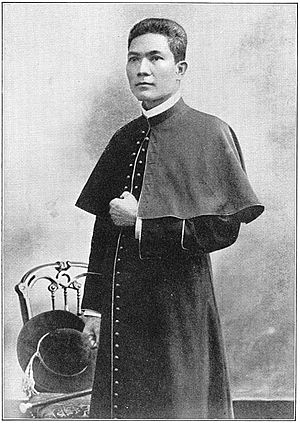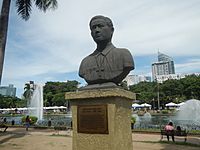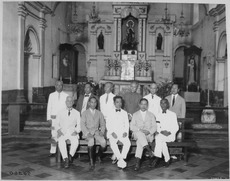Gregorio Aglipay facts for kids
Quick facts for kids The Most Reverend Monsignor Gregorio Aglipay,Obispo Máximo I D.D. |
|
|---|---|
| 1st Supreme Bishop of the Philippine Independent Church | |

Gregorio Aglipay, circa 1905.
|
|
| Church |
|
| Enthroned | September 6, 1902 |
| Reign ended | September 1, 1940 |
| Predecessor | Position created |
| Successor | Santiago Antonio Fonacier y Suguitan |
| Orders | |
| Ordination |
|
| Consecration |
|
| Rank |
|
| Personal details | |
| Birth name | Gregorio Aglipay Cruz y Labayán |
| Born | May 5, 1860 Batac, Ilocos Norte, Captaincy General of the Philippines, Spanish Empire |
| Died | September 1, 1940 (aged 80) Manila, Philippine Commonwealth |
| Buried | Aglipay National Shrine, Batac, Ilocos Norte, Philippines |
| Nationality | Filipino |
| Denomination |
|
| Spouse |
Pilar Jamias y Ver
(m. 1939) |
| Children | 1 |
| Occupation | Religious leader, guerrilla leader, political activist, politician |
| Profession | Catholic priest, Monsignor, Bishop of Aglipayan Church |
| Alma mater | Colegio de San Juan de Letran (AB) University of Santo Tomas (dropped out) Immaculate Conception School of Theology (Vigan Seminary) |
| Motto | "Serve the people!" |
| Sainthood | |
| Feast day | September 5 |
| Venerated in |
|
| Title as Saint | Bishop, Witness, and Visionary |
| Shrines | Aglipay National Shrine, Batac, Ilocos Norte Gregorio Aglipay Shrine, Pinili, Ilocos Norte |
| Styles of Gregorio Aglipay |
|
|---|---|
 |
|
| Reference style | His Eminence |
| Spoken style | Your Eminence |
| Religious style | Obispo Máximo I Monsignor The Most Reverend |
|
Gregorio Aglipay
|
|
|---|---|
| Member of the Malolos Congress from Ilocos Norte | |
| In office September 15, 1898 – November 13, 1899 Serving with Pedro Paterno, Primitivo Donato, Martín García, José Luna, and Pio Romero
|
|
| Personal details | |
| Political party | Republican (1905–1935) |
| Other political affiliations |
Independent (until 1905) |
| Military service | |
| Allegiance | |
| Branch/service | |
| Rank | |
| Battles/wars | Philippine–American War |
Gregorio Aglipay Cruz y Labayán (born May 5, 1860 – died September 1, 1940) was a Filipino Roman Catholic priest. He later became a revolutionary leader. He is best known as the first head of the Iglesia Filipina Independiente. This was an independent Christian church in the Philippines. It was also known as the "Aglipayan Church" after him.
Aglipay was known for encouraging Filipino clergy to be patriotic. This happened during the Philippine Revolution and the Philippine–American War. He was also a political activist. He met Isabelo de los Reyes, who helped start the independent Filipino Christian Church in 1902. This church was a protest against the Roman Catholic Church. Filipinos felt mistreated by the Spanish friars at the time.
Aglipay was removed from the Roman Catholic Church in 1899. This was because he was involved in revolutionary activities. He later joined Freemasonry in 1918. He married Pilar Jamias y Ver in 1939 and died a year later. People who follow the Aglipayan Church are sometimes called Aglipayans.
Contents
Early Life and Studies
Gregorio Aglipay was born in Batac, Ilocos Norte, on May 5, 1860. He was baptized into the Roman Catholic Church a few days later. He was the third child of Pedro Aglipay Cruz and Victoriana Labayán. He became an orphan when he was young. Relatives raised him in the tobacco fields. This was during the last years of Spanish rule in the Philippines.
He felt strongly about the unfair treatment by the Spanish government. He was arrested at age fourteen for not meeting his tobacco quota. In 1876, he moved to Manila to study law. His uncle helped him financially.
Aglipay studied at the Colegio de San Juan de Letran in 1878. He then went to the University of Santo Tomas in 1882. There he met José Rizal, a famous Filipino hero. After getting his Bachelor of Arts degree, he stopped studying law. He entered the seminary in Vigan, Ilocos Sur, in 1883.
He became a priest on December 21, 1889. He then worked as an assistant priest in different areas of Luzon. While serving in Victoria, Tarlac, Aglipay secretly helped the revolutionaries. He organized a group called Liwanag ("Light"). This group was connected to the Katipunan.
Role in the Philippine Revolution
In 1896, a secret society called Katipunan was discovered. It was led by Andrés Bonifacio. The Archbishop of Manila asked Aglipay to talk to the revolutionary leaders. He was to offer them some autonomy if they stopped fighting. However, General Emilio Aguinaldo asked Aglipay to join the rebellion. Aglipay agreed and became a military chaplain for the revolutionary government.
Aglipay also became a member of the Malolos Congress. This was the group that created the first Philippine Republic. He was the only religious person there. On October 20, 1898, Aguinaldo made Aglipay the Military Vicar General. This meant he was in charge of all military chaplains. As Aglipay traveled north, the Philippine–American War began.
During the Philippine–American War
When Aglipay returned to Manila, he found that the Americans had attacked. He joined the revolution. Fighting broke out on February 4, 1899. Aglipay went to Ilocos Norte to organize armed resistance. He was given the rank of lieutenant-general.
On April 29, 1899, the Archbishop of Manila removed Aglipay from the Roman Catholic Church. This was because Aglipay was taking over church duties.
Aglipay was one of the last generals to surrender to the Americans. He saw that his side had little chance of winning. On April 28, 1901, he surrendered in Laoag. This was to prevent more of his men from being hurt. After surrendering, he returned to Manila. He tried to make peace with the Roman Catholic Church. The war officially ended on July 2, 1902. Everyone who fought was given a full pardon.
Founding the Philippine Independent Church
After the war, in 1902, writer Isabelo de los Reyes wanted to form a Filipino church. This church would be independent from Rome. Spanish friars still controlled many churches in the Philippines. On August 3, de los Reyes announced the new church. He suggested that Aglipay be its first head bishop.
Aglipay was a very religious Catholic, even after being removed from the church. He was unsure about starting a new church. But he eventually accepted de los Reyes' offer on September 6, 1902. He became the first Supreme Bishop or Obispo Máximo of the "Philippine Independent Church". It was also called the "Aglipayan Church."
Historian Teodoro Agoncillo said Aglipay decided to join the new church after a meeting with a Jesuit priest named Francisco Foradada. The Jesuits wanted Aglipay to return to the Roman Catholic Church. They even offered him a high position and money. Aglipay wanted to make sure Filipino priests would get important roles. Foradada said Filipino priests were not good enough. Aglipay was very insulted by this. He left the meeting and decided to lead the new independent church.
Aglipay also talked with American Protestant leaders. He hoped they would help his new Filipino church. But they found the new church too similar to the Roman Catholic Church. They also did not want Filipino church leaders at that time.
Aglipay celebrated his first mass as the Supreme Bishop on October 26, 1902. On January 18, 1903, he was officially made Supreme Bishop. This was done by other bishops of the new Church. As Supreme Bishop, he supported nationalist and radical political groups.
Aglipay later changed some of his religious beliefs. He rejected the idea of the Trinity. He became more open to Unitarian ideas. However, many in his own Church did not agree with these changes.
Later Life and Legacy


Gregorio Aglipay joined Freemasonry later in his life. In 1935, Aglipay ran for President of the Commonwealth. This was the first nationwide election in the Philippines. He ran with Norberto Nabong as his running mate. They both lost to Manuel L. Quezon. Aglipay was the first religious leader to run for president in the Philippines. He accepted his defeat and congratulated Quezon.
His followers often called him Apo Aglipay. He married Pilar Jamias y Ver in 1939. She was a teacher from Sarrat, Ilocos Norte. His Church allowed priests to marry. He died the next year, on September 1, 1940, at age 80. He had a daughter named Liwliwa, born in 1913, before he married Pilar. Liwliwa helped him translate letters. She died in 1938.
Aglipay remained Supreme Bishop until his death. He is buried at the Cathedral of Saint Mary in Batac, Ilocos Norte.
The city of Batac, Ilocos Norte, celebrates September 1st as a special holiday. It is called "Gregorio L. Aglipay Day." This day remembers his death anniversary.
See also
 In Spanish: Gregorio Aglipay para niños
In Spanish: Gregorio Aglipay para niños
Images for kids








